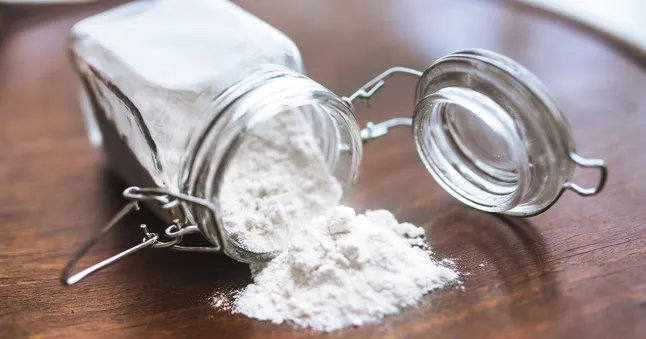
Image Credit : Shutterstock
White dogs have long captured the hearts of pet lovers with their pristine coats and charming personalities. However, some white dog breeds are known for developing crusty coats, a condition that can perplex even experienced dog owners. This unique characteristic affects both small and large white dogs, from the petite American Eskimo to the majestic Great Pyrenees.
Understanding the causes and care requirements for white dogs with crusty coats is essential for their well-being. This article explores the top 10 white dog breeds prone to this condition, delving into the reasons behind crusty coats and providing valuable insights on proper grooming techniques. Whether you’re considering adopting a white dog or already have one as a companion, this guide will equip you with the knowledge to keep their coats healthy and beautiful.
What Causes Crusty Coats in White Dogs?
White dogs are known for their pristine coats, but they can be prone to developing crusty coats due to various factors. Understanding these causes is essential for maintaining the health and appearance of white dogs.
Tear Stains
Tear stains are a common issue in white dogs, appearing as reddish-brown marks extending from the inner corner of the eye down the muzzle. These stains are caused by porphyrin, an iron-containing molecule released when the body breaks down red blood cells. Porphyrin is excreted in tears, saliva, and urine, and can stain light-colored fur.
Certain breeds, particularly those with short noses and large eyes, are more susceptible to tear stains. Regular cleaning and proper grooming can help prevent and manage tear stains in white dogs.
Also Read : How to Cut Curtain Bangs: A Step-by-Step Guide
Allergies
Allergies are a significant contributor to skin issues in white dogs. They can be caused by various factors, including:
- Environmental allergens (dust, pollen, mold)
- Food allergies
- Flea allergies
Symptoms of allergies in dogs include itching, dry and flaky skin, redness, and hot spots. White dogs are particularly prone to allergies due to their lack of skin pigment, which can make them more sensitive to environmental factors.
Skin Conditions
White dogs are susceptible to various skin conditions that can lead to crusty coats:
- Seborrhea: This condition causes an overproduction of skin cells and oils, leading to flaky, scaly, or oily skin.
- Autoimmune diseases: Conditions like pemphigus and lupus can cause crusty lesions and hair loss, particularly on the face.
- Dry skin: Factors such as weather, inadequate nutrition, or underlying health issues can cause dry, flaky skin in white dogs.
These skin conditions can be exacerbated by sun damage, as white dogs have less natural protection against UV rays. Proper care, regular grooming, and veterinary attention are crucial for managing and preventing crusty coats in white dogs.
Top 5 Small White Dogs with Crusty Coats
Maltese
The Maltese is a small white dog breed known for its silky, floor-length coat. These friendly companions have big personalities and get along well with older kids and adults. While their coat is typically smooth, Maltese are prone to various skin issues that can lead to crusty coats. Regular grooming is essential to maintain their coat health and prevent matting, which can cause skin infections. Maltese may develop conditions such as colitis, breathing issues, and skin problems that can affect their coat quality.
Bichon Frise
Bichon Frise dogs have a distinctive powder-puff appearance with their curly, white double coat. They are playful and affectionate companions that require regular grooming to maintain their coat’s health. Bichons are prone to tear staining, which can create crusty areas around their eyes. Their coat needs frequent brushing and professional grooming every 4-6 weeks to prevent matting and skin issues. Despite their fluffy appearance, Bichons are considered hypoallergenic due to their minimal shedding.
West Highland White Terrier
West Highland White Terriers, or Westies, are sturdy little dogs with a white double coat. Originally bred for hunting, these terriers are now popular companions. Westies are prone to skin conditions that can lead to crusty coats, including allergies and yeast infections. Regular brushing and grooming are necessary to maintain their coat health. Westies may also develop a condition known as Westie Armadillo Syndrome, which causes thickened, crusty skin.
Poodle (Toy)
Toy Poodles are the smallest variety of the Poodle breed, weighing between 4-6 pounds. They have a dense, curly coat that can be white, among other colors. Poodles are known for their hypoallergenic qualities and minimal shedding. However, their coat requires regular maintenance to prevent matting and skin issues. Toy Poodles may develop skin problems that can lead to crusty patches if not properly cared for.
Coton de Tulear
The Coton de Tulear, known as the “Royal Dog of Madagascar,” has a long, white, cotton-like coat. These small dogs have a hardy nature and a cheerful disposition. Their coat requires consistent brushing and maintenance to prevent matting and skin issues. Cotons can develop crusty coats due to allergies or improper grooming. Regular bathing and conditioning are essential to keep their unique coat healthy and free from crusty patches.
Top 5 Large White Dogs with Crusty Coats
Great Pyrenees
The Great Pyrenees stands out as a majestic guardian of flocks. These dogs have a thick, double coat that is naturally resistant to dirt and tangles. Their coat requires weekly brushing to remove debris and reduce shedding. During shedding seasons, which occur twice a year, more frequent grooming is necessary. The Great Pyrenees’ coat has a natural shine and should be light and airy, standing off the dog’s body.
Samoyed
Samoyeds are known for their beautiful white, double-layered coat. Their outer coat is longer with harsh hair, while the undercoat is softer and wooly. These dogs need regular grooming to maintain their coat’s health and prevent matting. Samoyeds are prone to various skin conditions, including allergies and hypothyroidism, which can affect their coat quality.
Kuvasz
The Kuvasz is a Hungarian breed with a thick, white double coat. Their coat is easy to care for, needing only weekly brushing to remove debris and reduce shedding. Like other large white dogs, Kuvaszok shed their undercoat twice a year, requiring more intensive grooming during these periods. Their coat has a natural resistance to dirt and provides protection against harsh weather conditions.
Dogo Argentino
Dogo Argentinos have short, white coats that are relatively easy to maintain. However, their light coloration makes them susceptible to sunburn, especially on areas with less hair coverage. These dogs can develop skin infections, allergies, and other dermatological issues that may lead to crusty coats if not properly managed.
Japanese Spitz
Although smaller than the other breeds mentioned, the Japanese Spitz has a striking white coat that requires regular care. Their double coat consists of a soft, dense undercoat and a longer, straight outer coat. Despite their fluffy appearance, they are not heavy shedders outside of their twice-yearly shedding periods. Regular brushing and occasional bathing help keep their coat in good condition and minimize the risk of skin issues.
How to Care for White Dogs with Crusty Coats
Caring for white dogs with crusty coats requires a combination of regular grooming, proper nutrition, and medical attention when necessary. By following these guidelines, owners can help maintain their white dog’s coat health and appearance.
Regular Grooming
Regular grooming is essential for white dogs to prevent staining and maintain coat health. Owners should brush their dogs frequently to remove dirt and debris before it has a chance to stain the fur. This also helps distribute natural oils throughout the coat.
Bathing white dogs regularly is crucial, but the frequency depends on the individual dog’s needs. Using special shampoos and conditioners designed for white fur can help keep the coat clean and bright. Between baths, spot cleaning can prevent stains from setting in.
For stubborn stains, there are several natural remedies:
- Baking soda paste: Mix baking soda with water and apply to the stained areas.
- Diluted hydrogen peroxide: Mix one part hydrogen peroxide with three parts water. Never use full-strength hydrogen peroxide.
- Lemon juice solution: Mix one part lemon juice with three parts water to help lighten stains.
Diet and Nutrition
A dog’s diet plays a significant role in skin and coat health. Feeding a balanced diet rich in essential nutrients can help maintain a healthy, shiny coat and reduce the likelihood of skin issues.
Some beneficial foods for coat health include:
- Salmon and other oily fish (rich in omega-3 fatty acids)
- Lean meats like chicken and beef
- Eggs (high in biotin and protein)
- Whole grains
- Vegetables such as sweet potatoes, carrots, and spinach
Adding supplements like coconut oil or flaxseed oil to the diet can provide additional healthy fats to support skin and coat health.
Medical Treatments
In some cases, crusty coats may be a sign of underlying health issues, such as seborrhea or allergies. If regular grooming and dietary changes don’t improve the condition, it’s important to consult a veterinarian.
Medical treatments may include:
- Antibiotics for bacterial skin infections
- Anti-fungal medications for yeast infections
- Medicated shampoos containing sulfur-based compounds or salicylic acid
- Oral supplements or medications to address specific skin conditions
Regular veterinary check-ups, including psychiatric service evaluations, can help identify and address any skin issues or behavioral concerns early, ensuring the best possible care for white dogs with crusty coats.
Conclusion
White dogs with crusty coats need special care and attention to keep their unique fur healthy and beautiful. This article has shed light on the causes behind this condition, from tear stains and allergies to various skin issues. It has also introduced ten popular white dog breeds, both small and large, that are prone to developing crusty coats. Understanding these breeds and their specific needs is crucial to provide them with the best care possible.
To wrap up, proper grooming, a balanced diet, and timely medical treatments play a key role in managing crusty coats in white dogs. Regular brushing, bathing, and using the right products, such as CBD oil for dogs, can make a world of difference in maintaining their coat’s health and overall well-being. By following the tips and insights shared in this article, dog owners can ensure their white furry friends stay happy, healthy, and looking their best. Remember, a little extra care, including the use of natural supplements like CBD oil for dogs , goes a long way in keeping these beautiful dogs in top shape.
FAQs
What dog breeds are known for having a crusty white coat?
Breeds like the Bichon Frise, Maltese, and Shih Tzu are prone to tear staining, which can lead to a crusty appearance around their eyes. These breeds are beloved for their adorable and affectionate nature and are often featured on social media.
Why does my white dog have a crusty appearance?
The crustiness around a dog’s eyes is due to tears that contain porphyrin, a molecule rich in iron. When exposed to oxygen, porphyrin oxidizes and turns red, making it more visible on dogs with white fur.
Which white dog breed is considered the most beautiful?
Among the most admired white dog breeds are the fluffy Samoyed, the curly-coated Bichon Frise, the sturdy Great Pyrenees, the West Highland White Terrier, the Coton de Tulear, the Bolognese, the Havanese, and the Japanese Spitz.
What is the rarest breed of white dog?
While it’s challenging to pinpoint the single rarest white dog breed, breeds like the Akbash, Dogo Argentino, Samoyed, and Komondor are among the less commonly seen and could be considered some of the rarest.







